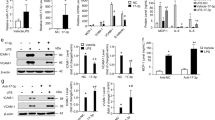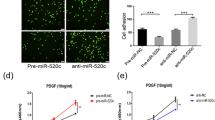Abstract
Intercellular adhesion molecule-1 (ICAM-1) in endothelial cells is critical for neutrophil adhesion and transmigration across the endothelium. Focal adhesion kinase (FAK), which controls the turnover of focal adhesion to regulate cell adhesion and migration, plays a role in the resolution of inflammation. However, the coordinated involvement of ICAM-1 and FAK during endothelial inflammation has yet to be elucidated. This study reports that, as part of an inflammatory response, ICAM-1 controls FAK expression in endothelial cells via the microRNA miR-15b-5p. Induction of lung injury by lipopolysaccharide (LPS) resulted in higher levels of FAK expression in inflammatory tissues, while in ICAM-1 knockout mice, FAK expression was reduced in the lungs. FAK expression was also reduced in endothelial cells following ICAM-1 siRNA downregulation. Furthermore, ICAM-1 inhibited miR-15b-5p expression while increasing FAK mRNA and protein expression via binding of miR-15b-5p to the 3′ untranslated region (UTR) of FAK. ICAM-1 inhibited miR-15b-5p promoter activity and hence reduced miR-15b-5p expression. FAK increased endothelial cell proliferation and migration, whereas miR-15b-5p inhibited cell proliferation and migration. These findings indicate that the inflammatory molecule ICAM-1 regulates FAK expression via miR-15b-5p levels, which in turn controls endothelial cell proliferation and migration.






Similar content being viewed by others
Availability of Data and Materials
All data generated or analyzed during this study are included in this published article.
References
Lawson, C., and S. Wolf. 2009. ICAM-1 signaling in endothelial cells. Pharmacological Reports 61: 22–32.
Liu, G., A.T. Place, Z. Chen, V.M. Brovkovych, S.M. Vogel, W.A. Muller, R.A. Skidgel, A.B. Malik, and R.D. Minshall. 2012. ICAM-1–activated Src and eNOS signaling increase endothelial cell surface PECAM-1 adhesivity and neutrophil transmigration. Blood 120: 1942–1952.
Yusuf-Makagiansar, H., M.E. Anderson, T.V. Yakovleva, J.S. Murray, and T.J. Siahaan. 2002. Inhibition of LFA-1/ICAM-1 and VLA-4/VCAM-1 as a therapeutic approach to inflammation and autoimmune diseases. Medicinal Research Reviews 22: 146–167.
Bui, T.M., H.L. Wiesolek, and R. Sumagin. 2020. ICAM-1: A master regulator of cellular responses in inflammation, injury resolution, and tumorigenesis. J Leukocyte Biol 108: 787–799.
Owen, J.D., P.J. Ruest, D.W. Fry, and S.K. Hanks. 1999. Induced focal adhesion kinase (FAK) expression in FAK-null cells enhances cell spreading and migration requiring both auto- and activation loop phosphorylation sites and inhibits adhesion-dependent tyrosine phosphorylation of Pyk2. Molecular and Cellular Biology 19: 4806–4818.
Zhao, X., and J. Guan. 2011. Focal adhesion kinase and its signaling pathways in cell migration and angiogenesis. Adv Drug Deliver Rev 63: 610–615.
Lim, S.S. 2013. Nuclear FAK: A new mode of gene regulation from cellular adhesions. Molecules and Cells 36: 1–6.
Zhou, J., Yi, Q., and L. Tang. 2019. The roles of nuclear focal adhesion kinase (FAK) on Cancer: a focused review. J Exp Clin Canc Res 38.
Petridou, N.I., P. Stylianou, and P.A. Skourides. 2013. A dominant-negative provides new insights into FAK regulation and function in early embryonic morphogenesis. Development 140: 4266–4276.
Roycroft, A., A. Szabó, I. Bahm, L. Daly, G. Charras, M. Parsons, and R. Mayor. 2018. Redistribution of Adhesive Forces through Src/FAK Drives Contact Inhibition of Locomotion in Neural Crest. Developmental Cell 45: 565–579.
Shen, T.L., A.Y. Park, A. Alcaraz, X. Peng, I. Jang, P. Koni, R.A. Flavell, H. Gu, and J.L. Guan. 2005. Conditional knockout of focal adhesion kinase in endothelial cells reveals its role in angiogenesis and vascular development in late embryogenesis. Journal of Cell Biology 169: 941–952.
Zhao, X., X. Peng, S. Sun, A.Y. Park, and J.L. Guan. 2010. Role of kinase-independent and -dependent functions of FAK in endothelial cell survival and barrier function during embryonic development. Journal of Cell Biology 189: 955–965.
Arnold, K.M., Z.M. Goeckeler, and R.B. Wysolmerski. 2013. Loss of focal adhesion kinase enhances endothelial barrier function and increases focal adhesions. Microcirculation 20: 637–649.
Bikis, C., D. Moris, I. Vasileiou, E. Patsouris, and S. Theocharis. 2015. FAK/Src family of kinases: Protective or aggravating factor for ischemia reperfusion injury in nervous system? Expert Opin Ther Tar 19: 539–549.
Wang, T., Jin, H., Hu, J., Li, X., Ruan, H., Xu, H., Wei, L., Dong, W., Teng, F., and J. Gu. et al. 2020. COL4A1 promotes the growth and metastasis of hepatocellular carcinoma cells by activating FAK-Src signaling. J Exp Clin Canc Res 39.
Yasuda, M., Y. Tanaka, M. Tamura, K. Fujii, M. Sugaya, T. So, M. Takenoyama, and K. Yasumoto. 2001. Stimulation of beta1 integrin down-regulates ICAM-1 expression and ICAM-1-dependent adhesion of lung cancer cells through focal adhesion kinase. Cancer Research 61: 2022–2030.
Nakayamada, S., Y. Okada, K. Saito, M. Tamura, and Y. Tanaka. 2003. β1 Integrin/Focal Adhesion Kinase-mediated Signaling Induces Intercellular Adhesion Molecule 1 and Receptor Activator of Nuclear Factor κB Ligand on Osteoblasts and Osteoclast Maturation. Journal of Biological Chemistry 278: 45368–45374.
Taglia, L., D. Matusiak, K.A. Matkowskyj, and R.V. Benya. 2007. Gastrin-releasing peptide mediates its morphogenic properties in human colon cancer by upregulating intracellular adhesion protein-1 (ICAM-1) via focal adhesion kinase. Am J Physiol-Gastr L 292: G182–G190.
Lu, TX., M.E. Rothenberg. 2018. MicroRNA. J Allergy Clin Immun 141: 1202–1207.
Cai, Y., X. Yu, S. Hu, and J. Yu. 2009. A Brief Review on the Mechanisms of miRNA Regulation. Genomics, Proteomics & Bioinformatics 7: 147–154.
Pekarsky, Y., and C.M. Croce. 2015. Role of miR-15/16 in CLL. Cell Death and Differentiation 22: 6–11.
Wang, J., S. Yao, Y. Diao, Y. Geng, Y. Bi, and G. Liu. 2020. miR-15b enhances the proliferation and migration of lung adenocarcinoma by targeting BCL2. Thorac Cancer 11: 1396–1405.
Sun, L., Y. Yao, B. Liu, Z. Lin, L. Lin, M. Yang, W. Zhang, W. Chen, C. Pan, Q. Liu, et al. 2012. MiR-200b and miR-15b regulate chemotherapy-induced epithelial-mesenchymal transition in human tongue cancer cells by targeting BMI1. Oncogene 31: 432–445.
Lovat, F., M. Fassan, P. Gasparini, L. Rizzotto, L. Cascione, M. Pizzi, C. Vicentini, V. Balatti, D. Palmieri, S. Costinean, and C.M. Croce. 2015. miR-15b/16-2 deletion promotes B-cell malignancies. Proceedings of the National Academy of Sciences 112: 11636–11641.
Qi, L.Q., B. Sun, B.B. Yang, and S. Lu. 2020. MiR-15b facilitates breast cancer progression via repressing tumor suppressor PAQR3. European Review for Medical and Pharmacological Sciences 24: 740–748.
Zhu, L., J. Zhou, J. Zhang, J. Wang, Z. Wang, M. Pan, L. Li, L. Chen, C. Li, K. Wang, et al. 2017. MiR-15b-5p Regulates Collateral Artery Formation by Targeting AKT3 (Protein Kinase B-3). Arteriosclerosis, Thrombosis, and Vascular Biology 37: 957–968.
Zhu, L.P., J.P. Zhou, J.X. Zhang, J.Y. Wang, Z.Y. Wang, M. Pan, L.F. Li, C.C. Li, K.K. Wang, Y.P. Bai, and G.G. Zhang. 2017. MiR-15b-5p Regulates Collateral Artery Formation by Targeting AKT3 (Protein Kinase B-3). Arteriosclerosis, Thrombosis, and Vascular Biology 37: 957–968.
Gu, W., L. Yao, L. Li, J. Zhang, A.T. Place, R.D. Minshall, and G. Liu. 2017. ICAM-1 regulates macrophage polarization by suppressing MCP-1 expression via miR-124 upregulation. Oncotarget 8: 111882–111901.
Yan, M., X. Zhang, A. Chen, W. Gu, J. Liu, X. Ren, J. Zhang, X. Wu, A.T. Place, R.D. Minshall, and G. Liu. 2017. Endothelial cell SHP-2 negatively regulates neutrophil adhesion and promotes transmigration by enhancing ICAM-1–VE-cadherin interaction. The FASEB Journal 31: 4759–4769.
Bae, G.H., H.Y. Lee, Y.S. Jung, J.W. Shim, S.D. Kim, S.H. Baek, J.Y. Kwon, J.S. Park, and Y.S. Bae. 2012. Identification of novel peptides that stimulate human neutrophils. Experimental & Molecular Medicine 44: 130–137.
Downey, D.G., S.C. Bell, and J.S. Elborn. 2009. Neutrophils in cystic fibrosis. Thorax 64: 81–88.
Sumagin, R., J.C. Brazil, P. Nava, H. Nishio, A. Alam, A.C. Luissint, D.A. Weber, A.S. Neish, A. Nusrat, and C.A. Parkos. 2016. Neutrophil interactions with epithelial-expressed ICAM-1 enhances intestinal mucosal wound healing. Mucosal Immunology 9: 1151–1162.
Mehta, D., and A.B. Malik. 2006. Signaling mechanisms regulating endothelial permeability. Physiological Reviews 86: 279–367.
Roy-Luzarraga, M., and K. Hodivala-Dilke. 2016. Molecular Pathways: Endothelial Cell FAK-A Target for Cancer Treatment. Clinical Cancer Research 22: 3718–3724.
Schmidt, T.T., M. Tauseef, L. Yue, M.G. Bonini, J. Gothert, T.L. Shen, J.L. Guan, S. Predescu, R. Sadikot, and D. Mehta. 2013. Conditional deletion of FAK in mice endothelium disrupts lung vascular barrier function due to destabilization of RhoA and Rac1 activities. American Journal of Physiology. Lung Cellular and Molecular Physiology 305: L291–L300.
Wu, B., G. Liu, Y. Jin, T. Yang, D. Zhang, L. Ding, F. Zhou, Y. Pan, and Y. Wei. 2020. miR-15b-5p Promotes Growth and Metastasis in Breast Cancer by Targeting HPSE2. Frontiers in Oncology 10: 108.
Fleming, N.H., J. Zhong, S.I. Da, D.M.E. Vega-Saenz, B. Brady, S.W. Han, D. Hanniford, J. Wang, R.L. Shapiro, E. Hernando, and I. Osman. 2015. Serum-based miRNAs in the prediction and detection of recurrence in melanoma patients. Cancer-Am Cancer Soc 121: 51–59.
Zhu, Y., T. Yang, J. Duan, N. Mu, and T. Zhang. 2019. MALAT1/miR-15b-5p/MAPK1 mediates endothelial progenitor cells autophagy and affects coronary atherosclerotic heart disease via mTOR signaling pathway. Aging (Albany NY) 11: 1089–1109.
Niu, S., L. Xu, Y. Yuan, S. Yang, H. Ning, X. Qin, P. Xin, D. Yuan, J. Jiao, and Y. Zhao. 2020. Effect of down-regulated miR-15b-5p expression on arrhythmia and myocardial apoptosis after myocardial ischemia reperfusion injury in mice. Biochemical and Biophysical Research Communications 530: 54–59.
Chava, S., C.P. Reynolds, A.S. Pathania, S. Gorantla, L.Y. Poluektova, D.W. Coulter, S.C. Gupta, M.K. Pandey, and K.B. Challagundla. 2020. miR-15a-5p, miR-15b-5p, and miR-16-5p inhibit tumor progression by directly targeting MYCN in neuroblastoma. Molecular Oncology 14: 180–196.
Shelef, M.A., D.A. Bennin, N. Yasmin, T.F. Warner, T. Ludwig, H.E. Beggs, and A. Huttenlocher. 2014. Focal adhesion kinase is required for synovial fibroblast invasion, but not murine inflammatory arthritis. Arthritis Research & Therapy 16: 464.
Chen, X.L., J.O. Nam, C. Jean, C. Lawson, C.T. Walsh, E. Goka, S.T. Lim, A. Tomar, I. Tancioni, S. Uryu, et al. 2012. VEGF-induced vascular permeability is mediated by FAK. Developmental Cell 22: 146–157.
Wong, V.W., K.C. Rustad, S. Akaishi, M. Sorkin, J.P. Glotzbach, M. Januszyk, E.R. Nelson, K. Levi, J. Paterno, I.N. Vial, et al. 2011. Focal adhesion kinase links mechanical force to skin fibrosis via inflammatory signaling. Nature Medicine 18: 148–152.
Funding
This project was supported financially by the National Natural Science Foundation of China (NSFC) (Grant Nos. 82104178 (W. Gu) and 31372418 (G. Liu)), Bengbu Medical College Scientific and Technology Self-Innovation Foundation Program, Grant No. BYKC201903 (G. Liu), and the Natural Science Research Project of Anhui Educational Committee, Grant No. KJ2021A0768 (W. Gu).
Author information
Authors and Affiliations
Contributions
WG and GL developed the concept and designed the studies, contributed to the data analysis and statistical analysis, and wrote and edited the manuscript. WG, LZ, XH and BY analyzed the in vivo and ex vivo studies and performed statistical analysis. LZ, XH and XY contributed to the experimental studies and data acquisition. All the authors read and approved the final manuscript.
Corresponding author
Ethics declarations
Ethics Approval and Consent to Participate
The study was conducted in accordance with guidelines developed by the China Council on Animal Care and Protocol. The procedures for care and use of animals were approved by the Ethics Committee of Bengbu Medical College, and all applicable institutional and governmental regulations concerning the ethical use of animals were followed.
Consent for Publication
Not applicable.
Competing Interests
The authors declare no competing interests.
Additional information
Publisher's Note
Springer Nature remains neutral with regard to jurisdictional claims in published maps and institutional affiliations.
Supplementary Information
Below is the link to the electronic supplementary material.
Rights and permissions
About this article
Cite this article
Gu, W., Zhang, L., Zhang, X. et al. MiR-15p-5p Mediates the Coordination of ICAM-1 and FAK to Promote Endothelial Cell Proliferation and Migration. Inflammation 45, 1402–1417 (2022). https://doi.org/10.1007/s10753-022-01630-3
Received:
Revised:
Accepted:
Published:
Issue Date:
DOI: https://doi.org/10.1007/s10753-022-01630-3




